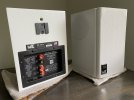Chilli
Member
True. Back then, I was going to splash out on a lexicon processor or a big Sony ldc proj. Instead, we waited a little and got a yamaha dsp a1. The new era of 5.1! The only thing still standing from back then is our mirage sub.The general benefits of studio sound design aside, this was still the era of "matrix" surround encoded into stereo tracks (a la Dolby Surround) with mediocre channel separation. Speakers with narrow directivity would definitely help enhance channel separation.






